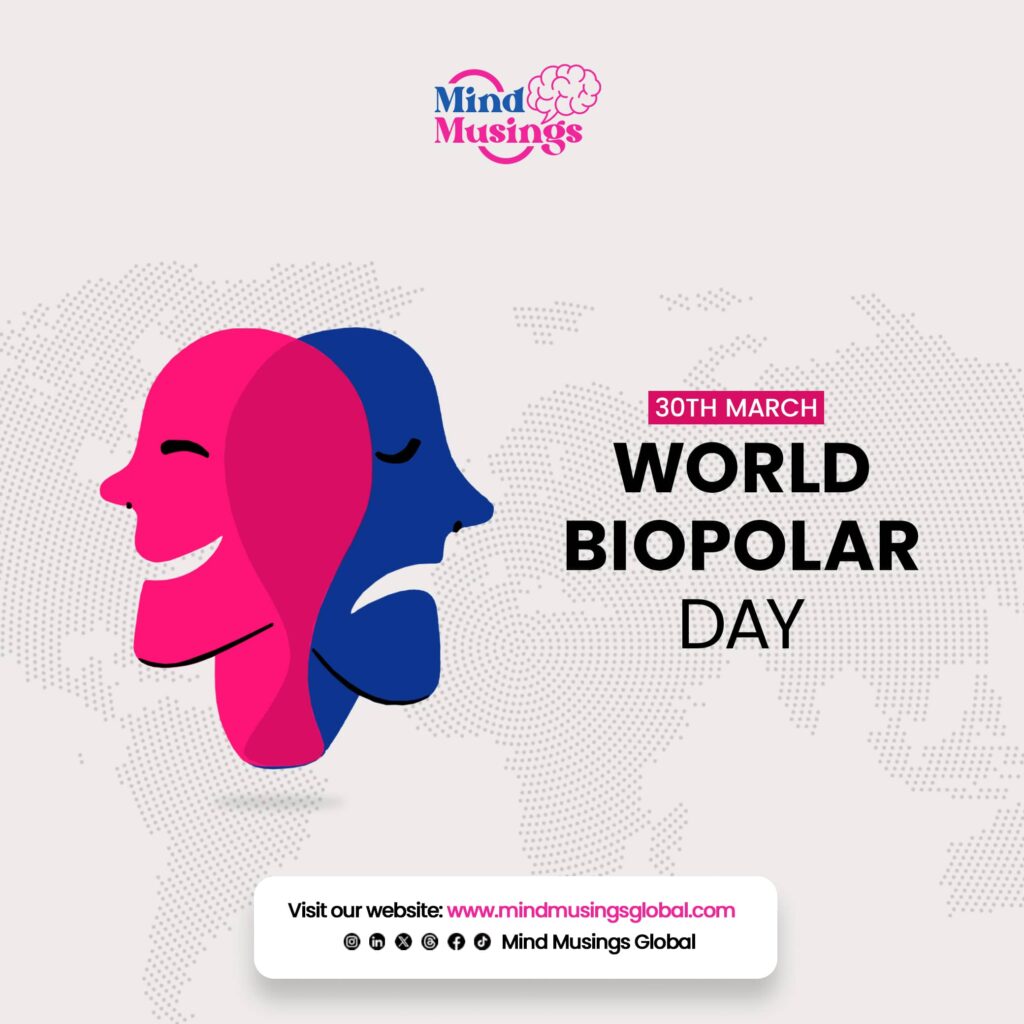Bipolar Disorder

Mental health has been a topic of growing importance, yet there are still various misconceptions. “Madness” is a term often used to describe unexplainable behaviour. Similarly, many mistakingly label individuals as “bipolar” after observing short-term fluctuations of their emotions or if they appear to be acting erratically.
The term “being bipolar” is often used casually, but many people are unfamiliar with its true meaning.
“Which of my feelings are real? Which of the mes is me? The wild, impulsive, chaotic, energetic, and crazy one? Or the shy, withdrawn, desperate, suicidal, doomed, and tired one? Probably a bit of both, hopefully much that is neither.”
― Kay Redfield Jamison, An Unquiet Mind: A Memoir of Moods and Madness
Defining Bipolar Disorder
The Mayo Clinic blog defines bipolar disorder, which was formally referred to as Manic depression, as a mental health condition characterized by extreme mood swings, encompassing emotional highs (mania or hypomania) and lows (depression). The severity and duration of these mood swings can vary significantly among individuals.
Mania or emotional highs, as defined by Cleveland Clinic, is a state that is marked by excessive energy, heightened activity, and noticeably exaggerated behaviours such as racing thoughts, rapid speech, and feelings of invincibility. These symptoms can manifest extreme elation or irritability and often disrupt daily life.
Hypomania, however, is a milder form of mania. Hypomania involves elevated energy levels and noticeable behavioural changes, but it is less severe and typically does not require hospitalization, unlike mania.
Depression, the emotional lows, are episodes of low mood, lack of energy, and loss of interest in activities.
Types of Bipolar Disorder
The American Psychiatric Association identifies five types of bipolar disorder based on the nature, duration, and severity of mood episodes. According to the Verywell Mind blog, the Diagnostic and Statistical Manual of Mental Disorders (DSM-5) published by the American Psychiatric Association, the types of bipolar disorders are:
- Bipolar I Disorder: Defined by at least one manic episode lasting seven days or requiring hospitalization, often accompanied by depressive episodes.
- Bipolar II Disorder: Characterized by patterns of depressive and hypomanic episodes without full-blown mania.
- Cyclothymic Disorder: Involves fluctuating periods of hypomania and mild depression that persist for at least two years.
- Other Specified Bipolar and Related Disorders: Diagnosed when symptoms do not fully meet the criteria for other types of bipolar disorder.
- Unspecified Bipolar and Related Disorders: Reserved for cases where insufficient information is available to specify the type.
Symptoms and Variations
The primary symptoms of bipolar disorder include episodes of mania or hypomania and major depressive episodes.
Signs and Symptoms of Manic Episodes
- Excessive happiness, anxious hopefulness and excitement.
- Extreme mood swings, such as going from being joyful to being angry and hostile.
- Restlessness.
- Rapid speech and racing thoughts.
- High energy and the need to sleep less.
- Being impulsive and making rash decisions, such as suddenly quitting your job.
- Making grand and unattainable plans.
- Reckless and risk-taking behaviour, such as drug and alcohol misuse and having unsafe or unprotected sex.
- Having elevated self-esteem, such as being unusually important, talented or powerful.
- Psychosis: experiencing hallucinations and delusions (in the most severe manic episodes).
Signs and symptoms of Hypomania
Symptoms of Hypomania are the same as those of Mania but are less intense. These are:
- Abnormally high level of activity or energy.
- Feeling extremely happy or excited.
- Not sleeping or only getting a few hours of sleep but still feeling rested.
- Having an inflated self-esteem, thinking you’re invincible.
- Being more talkative than usual. Not giving others a chance to contribute
- Thinking about multiple topics at the same time.
- Being easily distracted by unimportant or unrelated things.
- Being hyper-focused and absorbed in an activity.
- Displaying aimless movements, such as pacing around your home or office or fidgeting when you’re sitting.
- Showing spontaneous behaviour that can lead to poor choices, such as buying sprees, reckless sex or foolish business investments.
Hypomania is feeling good and getting a lot of work done. People with Hypomania often tend to function well in social situations and at work. They also feel like nothing is wrong during this episode, but their mood swings and changes in activity level may be noticed by those around them
Signs and Symptoms of Depressive episodes
- Overwhelming sadness, worthlessness and hopelessness.
- Reduced energy and fatigue.
- Lack of motivation.
- Loss of interest in things that were once pleasurable.
- Having difficulty concentrating and indecisiveness.
- Uncontrollable crying.
- Irritability.
- Insomnia or increased need for sleep.
- Fluctuations in appetite, thereby leading to weight loss or gain.
- Thoughts of suicide and self-harm
According to the Healthline Blog, depressive episodes can range from two (2) weeks to several months.
Other notable signs of Bipolar disorder include:
- Anxious distress
- Melancholy
- Psychosis (delusions or hallucinations)
It is also worth noting that Manic and depressive symptoms can occur at the same time in bipolar disorder. This is known as Mixed features. It is a main characteristic used to speculate that one might have bipolar disorder, and it is a common myth that people with bipolar disorder present these features all the time.
Mixed features appear as;
- Irritability or agitation
- Unprovoked rage
- Weeping spells
- Racing thoughts
- Insomnia.
During Mixed features, symptoms of mania and depression occur simultaneously, or “rapid cycling,” involving four or more mood episodes within a year.
Notably, the presentation of symptoms of bipolar disorder may differ across genders. Studies suggest that females are more prone to depressive episodes and relapses, while males are more likely to experience earlier onset and severe manic episodes.
Causes and Risk Factors
The exact causes of bipolar disorder remain unknown, but several contributing factors have been identified:
- Genetics: A family history of bipolar disorder increases the risk of developing the condition.
- Brain Chemistry: Changes in neurotransmitter functioning may play a role.
- Childhood Trauma: Adverse experiences during formative years are linked to increased vulnerability.
- Stressful Life Events: Major life changes or stress can trigger episodes.
- Neurological Changes: Structural and functional brain differences are observed in some individuals with bipolar disorder.
Coping Mechanisms
If you think you have bipolar disorder by recognizing some of the symptoms, it is advisable to speak to your doctor and get a proper diagnosis from a qualified psychiatrist.
After getting your diagnosis, it is important to learn more about bipolar disorder and how to live with it. Your psychiatrist should provide medications and tools to help manage your condition to adjust properly.
Some of the coping mechanisms for bipolar disorder are listed below.
- Sticking to a routine
- Getting consistent sleep
- Exercising regularly
- Eating foods that are good for your brain
To stay on track with treatment plans and find adequate ways to cope, it is essential to,
- Recognize triggers: Recognizing triggers is essential to know how particular situations affect you. It helps lower the chances of having episodes.
- Monitor moods: Keeping a record of fluctuations in your moods and what activates certain mood episodes is a great self-help strategy. Recording your moods daily in a journal (Journaling) is a great way to keep track of your moods for patterns to identify when an episode is currently occurring or about to occur.
Living with bipolar disorder or supporting someone who has it can feel overwhelming, but you are not alone. Mental health challenges are real, and so is the support available to help navigate them. Whether you’re experiencing extreme mood shifts, know someone who is, or simply want to understand more, remember that help is within reach.
Seeking professional guidance, building a strong support system, and using coping strategies can make a significant difference. If you’re struggling, reach out to a trusted friend, family member, or mental health professional. There is hope, and recovery is possible. You are not defined by your diagnosis. You are more than your highs and lows.
REFERENCES
- Mayo clinic, 2024. Bipolar Disorder. [Internet] Bipolar disorder – Symptoms and causes – Mayo Clinic. Accessed 4/03/2025
- Cleveland Clinic, 2021. Mania. [Internet] Mania: What Is It, Causes, Triggers, Symptoms & Treatment. Accessed 13/05/2025
- Cleveland Clinic, 2021. Hypomania. [Internet] Hypomania: What Is It, Comparison vs Mania, Symptoms & Treatment. Accessed 13/03/2025
- Cleveland Clinic, 2022. Bipolar Disorder. [Internet] Bipolar Disorder (Manic Depression): Symptoms & Treatment. Accessed 19/03/2025
- Diagnostic and Statistical Manual for Mental Disorders, 2013. [Internet] dsm-5_bipolar_and_related_diso_41789.pdf. Accessed 13/03/2025
- Linsday Toler, 2024. Are there different types of bipolar disorder? Verywell Mind Blog. [Internet] The 5 Types of Bipolar Disorder. Accessed 24/03/2025
- Traci Pedersen, 2023. What is Bipolar Depression? Healthline Blog. [Internet] Bipolar Depression: Symptoms, Diagnosis, and Treatment. Accessed 24/03/2025.
- Therese Borchard, 2020. 9 Essential Coping strategies for Bipolar Disorder. HealthCental Blog. [Internet] 9 Essential Coping Strategies for Bipolar Disorder. Accessed 25/03/2025
- PsychCentral, 2021. Coping with Bipolar Disorder: 5 Self-Help Strategies. [Internet] 5 Self-Help Strategies for Bipolar Disorder. Accessed 25/03/2025.
